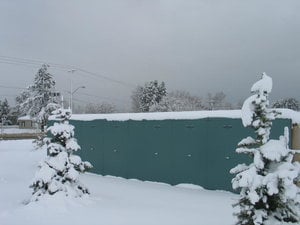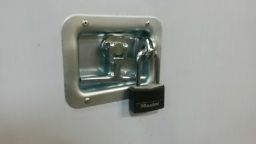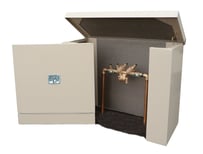There's a big difference between classes 1, 2, and 3
Class 1 is the hardest to achieve and backflow preventer covers which fit in  this class are commonly referred to as having freeze protection. In terms of the 1060 standard, freeze protection means the heated enclosure will maintain 40° in as low as -30° weather. If you are specifying in an area that freezes, no matter how long the freeze lasts, you should require class 1.
this class are commonly referred to as having freeze protection. In terms of the 1060 standard, freeze protection means the heated enclosure will maintain 40° in as low as -30° weather. If you are specifying in an area that freezes, no matter how long the freeze lasts, you should require class 1.
Class 2 only includes covers that have frost protection. This means the industrial enclosure is insulated, but does not come close to meeting the same temperature requirements as class 1. These should really only be specified in areas where temperatures never fall below 33° Fahrenheit.
Class 3 boxes provide no freeze or frost protection at all. These are really only useful for aesthetics as well as theft, vandal, and accident protection.
Not all Enclosure heaters are the same
In 2006, the ASSE standards council determined there should be new requirements regarding heaters in these backflow covers. Now, certain heaters are considered wet/damp certified once they have been tested in an ASSE laboratory. This means the heater can continue to operate even if it becomes damp or wet. This is important in all outdoor, above ground industrial enclosures as sometimes liquids may be introduced into the cover. It's especially important for reduced pressure zone backflow assemblies (RPZ), because they are designed to dump water during normal use. When they fail, they can produce 500 gallons of liquids per minute. Not every ASSE certified enclosure contains a wet/damp certified heater. If you're specifying an RPZ, this an incredibly important distinction.
Download the enclosure design guide with the top 5 enclosure design considerations
High level of protection
All ASSE 1060 approved backflow enclosures must be capable of providing  security for the device. Obviously, this includes some sort of lock. It goes much further than that, however, with a test which a 20 lb dead weight drop. If, at the end of the test, the mechanism shows no evidence of damage and still functions, it passes. The structure itself is also tested and must be designed to support a vertical load of 100 pounds per square foot. These are just a couple examples of the rigorous safety tests.
security for the device. Obviously, this includes some sort of lock. It goes much further than that, however, with a test which a 20 lb dead weight drop. If, at the end of the test, the mechanism shows no evidence of damage and still functions, it passes. The structure itself is also tested and must be designed to support a vertical load of 100 pounds per square foot. These are just a couple examples of the rigorous safety tests.
Different kinds of drainage
Since RPZs are designed to dump water whether they're working correctly or failing, ASSE 1060 enclosures must include a way to drain water. If the protective box were to fill with water, it could create a cross connection with the backflow assembly itself through the test cocks. This would defeat the purpose of having a backflow preventer installed in the first place! In order for a backflow preventer cover to be ASSE 1060 approved, it is tested to make sure water will not rise more than 8" inside when a specified flow rate is introduced. There are different types of drains used in the industry, some of which are only holes. These pass the drainage requirements, but pose a big problem if your region requires any sort of frost or freeze protection.
Testing and maintenance safety
 Water jurisdictions dictate how often backflow preventer devices are supposed to be tested. Usually, they must be tested each year by a licensed tester. ASSE 1060 certified backflow enclosures must be designed with safety in mind for these testers and for maintenance technicians. For instance, if the enclosure is not large enough to stand in, there must be a method for any lid to be secured in a locked position when it is lifted. There are many other safety precautions in place. However, protective enclosures are not considered confined spaces by OSHA, so there are significantly fewer concerns to begin with.
Water jurisdictions dictate how often backflow preventer devices are supposed to be tested. Usually, they must be tested each year by a licensed tester. ASSE 1060 certified backflow enclosures must be designed with safety in mind for these testers and for maintenance technicians. For instance, if the enclosure is not large enough to stand in, there must be a method for any lid to be secured in a locked position when it is lifted. There are many other safety precautions in place. However, protective enclosures are not considered confined spaces by OSHA, so there are significantly fewer concerns to begin with.Now that you understand all the key points within the ASSE 1060 standard, be on the lookout for backflow covers with the seal of approval. They will offer the best quality protection for your expensive equipment.




